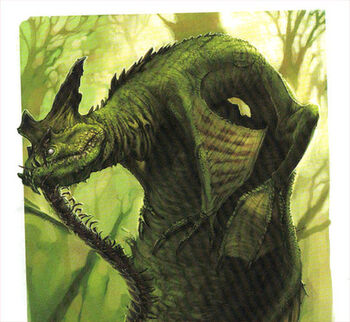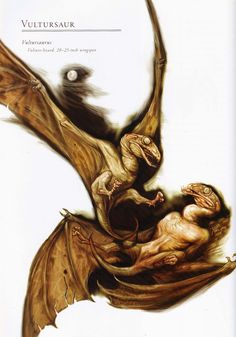|
Vultursaurus
| |
|
Name:
|
Vultursaurus
|
|
Abilities and Weapons:
|
flying, teeth, claws
|
|
Occupation:
|
Pursuit micropredator
|
|
Home:
|
Skull Island, now on Monster Isle
|
|
First Appearance:
|
"The World of Kong: A Natural History of Skull Island" (2005)
|
|
Diet:
|
Insectivore (insects)
|
|
Size:
|
Wingspan: 50.8-63.5 centimeters
Weight Estimated: 120-200 grams |
|
Status:
|
Flew to nearby land masses after Skull Island sank beneath the ocean.
|
Vultursaurus ("vulture lizard") is species of very small flying theropod dinosaurs with wingspan 20-25 inch in length (50.8-63.5 centimeters), that is found on Skull Island. The animal is described in the book "The World of Kong: A Natural History of Skull Island" (2005), but didn't appear on the 2005 film.
Name[]
Name comes from Sam Kelley's having initially mistaken it for a vulture, and upon seeing it more clearly dubbed it Vultursaurus.
Appearance[]
Vultursaurus is a strange, flying non-avian dinosaur from the chasms and jungles of Skull Island. Despite appearances, they are not pterosaurs. In fact they are the sole surviving representatives of a remarkable second dynasty of airborne theropods that have developed bat-like wing membranes instead of feathered wings. Their wings (which are not single sheets of skin as on pterosaurs) are divided by extended fingers. Broad and supple so that they can be realigned with ease and supple, their wings are able to be realigned with ease in flight. Their flapping is not as efficient as either a bird’s or bat’s but is more than sufficient to keep them aloft. Their wings are better suited to allow it to swim rather than fly.
Vultursaurus is described as having a fearsome looking "U-shaped" head with large eyes and eardrums, as well as needle-toothed jaws ending in a small beak, a sleek body, short tail and powerful, hind legs with an opposable toe claws. Its claws are incredibly sharp and are capable of tearing flesh on contact. However, due to their slight build, they cannot carry much weight with their feet. These flocking creatures are nocturnal, roosting on ledges or in deep jungle shade during the day, emerging in vast flocks to hunt insects, such as moths, at night. They have excellent night vision. They have reflective eyes that are able to discern distance and depth even in dim starlight. Only on the blackest nights are they grounded. They are heavily preyed upon by other ravine-dwelling species - a single Deplector can eat several dozen a night.
History[]
King Kong: The Island of the Skull[]
In their debut novel, a Vultursaurus preyed on Sam Kelley and his associates as they climbed down a rock face. It took one of them but was unable to escape Kelley's gunfire because its prey was too heavy. Another Vultursaurus waited for Kelley and his last remaining companion to get a bit farther away from the island, and when their boat struck a rock, and one of them was thrown from the ship's cabin. Seizing its opportunity, the Vulturesaurus went in for the kill. It successfully got a hold of the girl but was killed by Kelley with a gun.
Trivia[]

"Vultursaurus" from "King Kong: The Island of the Skull"
- Vultursaurus, like many other Skull Island creatures, has an entry in book 'The World of Kong: A Natural History of Skull Island" detailing its origin and biology.
- Two vastly different images of Vultursaurus exist. One from "King Kong: The Island of the Skull" and one from "The World of Kong: A Natural History of Skull Island". This is due to The Island of the Skull's cover art being published before the complete description and dimensions of the Vultursaurus had been made available. The design shown on the cover of "Island of the Skull" was reused for the flying lizard Aliepesaurus in the World of Kong.
- Vultursaurus resembles the real-life bat-winged dinosaur Yi qi, which was discovered 10 years after World of Kong was published.
- The Vultusaurus was the replacement of the Archaeopteryx from the 1933 film.

